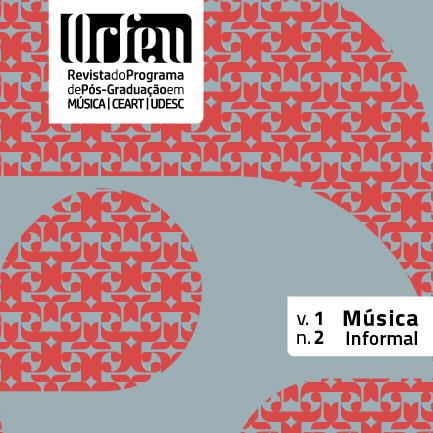Isso é ¿música? O som experimental a partir da apropriação das novas tecnologias
DOI:
https://doi.org/10.5965/2525534001022016060Palabras clave:
Pesquisa da sonoridade musical contemporânea, novas tecnologias na música, experimentação sonora, improvisação musicalResumen
Este artigo traz uma reflexão sobre a experimentação sonora e possíveis paradoxos entre música, som e linguagem na produção artística contemporânea, a partir da apropriação das novas tecnologias digitais. No momento em que um instrumento acústico é acoplado a uma interface capaz de processar seu sinal, temos acesso às potencialidades mais intrínsecas do som. Valendo-se de processos investigativos que podem realizar o intercâmbio de dados e sinais originados em instrumentos acústicos, eletrônicos, computadores móveis, controladores, smartphones, redes de comunicação sem fios, sensores, objetos amplificados, etc., a experimentação a partir de aparatos digitais abriu uma fenda irreversível na fatura sonora, ampliando as possibilidades artísticas; o experimento sonoro, sua criação e difusão, estão cada vez mais próximos da pele, do tato, cada vez mais próximos ao corpo humano. Ao expandirmos o foco para além dos aspectos tradicionais do ritmo, melodia e harmonia, que estão atrelados a um certo período da música ocidental, e partirmos para uma escuta intensificada, percebemos a potência que o som representa, com suas nuances expressivas. Assim, a apropriação das novas tecnologias nas práticas artísticas possibilita a criação de um tipo específico de performance e composição ancoradas numa manipulação e escuta mais detalhadas do som, que podem vir a ser desvinculadas de uma referencialidade específica.Descargas
Citas
BENITEZ, Joaquim M. Avant-Garde or Experimental? Classifying contemporary music. Internation Review of the Aesthetics and Sociology of Music, Vol. 9, ed. 1, p.53-77. Zagreb: HMD Ed., 1978.
CAMPESATO, Lilian. Deep Music. Texto publicado online, São Paulo: 2011. Disponível em http://liliancampesato.tumblr.com/post/7045853544/deep-music-a-instala%C3%A7%C3%A3o-consiste-na-constru%C3%A7%C3%A3o - Acesso em 23.8.23016.
COSTA, Rogério L. M. O músico enquanto meio e os territórios da livre improvisação. 2003. 179p. Tese (Doutorado em Comunicação e Semiótica). São Paulo, Programa de Pós-Graduação em Comunicação e Semiótica, PUC.
COSTA, Rogério L. M. A improvisação musical e suas conexões, Ano de obtenção. São Paulo: Tese de Livre-Docência, Escola de Comunicação e Artes, Universidade de São Paulo, 2013.
COSTA, Rogério L. M. A improvisação livre, a construção do som e a utilização das novas tecnologias. Revista Música Hodie, v. 15, num. 1, pp.119-131. Goiânia: UFG Ed., 2015.
DUE, Andreas Reidar. Deleuze. Cambridge: Polite Ed., 2007
EMMERSON, Simon. The language of electroacoustic music. New York: MacMillan Publishers, 1986.
FERGUNSON, Sean. De-Composing Tristan Murail: The Collected Writings, 1980-2000. Montreal: Les Presses de l´Université de Montréal, 2007.
GRISEY, Gérard. Écrits: ou l’invention de la musique spectrale. Édition réalisé pour Guy Lelong et Anne-Marie Réby. Paris: MF Éditions, 1991, 2008.
GUIGUE, Didier. Estética da Sonoridade. São Paulo: Perspectiva, 2011.
IAZZETTA, Fernando. Música e mediação tecnológica. São Paulo: Perspectiva, 2009.
JONES. Caroline A. Sensorium – embodied experience, technology and contemporary art. Massachusetts: The MIT Press, 2006.
LANDY, Leigh. What´s the matter with today´s experimental music? Switzerland: Harwood Academic Publishers, 1991.
LIMA, J. G. A. Observações sobre o papel das ferramentas digitais na música experimental contemporânea brasileira. 2013, 148kp. Dissertação (Mestrado em Processos de Criação Musical). São Paulo, Programa de Pós-Graduação em Música, Escola de Comunicação e Artes, Universidade de São Paulo.
MISKALO, Vitor K. ¿Música?: processos e práticas de criação e performance em um ambiente de pesquisas em sonologia. 2014. Tese (Doutorado em Processos de Criação Musical). São Paulo, Programa de Pós-Graduação em Música, Escola de Comunicação e Artes, Universidade de São Paulo.
NYMAN, Michael. Experimental Music – Cage and beyond. Cambridge: Cambridge University Press, 1999.
OLIVEROS, Pauline. Deep Listening: a composer´s sound practice. Bloomington: iUniverse Edit., 2005.
PALOMBINI, Carlos. Pierre Schaeffer – from research into noises to experimental music. Computer Music Journal, Vol. 17, ed. 3, pp.14-19. Massachusetts: MIT Press, 1993.
ROSS, Alex. The rest is noise. New York: Picador, 2007.
SANTAELLA, Lucia. Matrizes da linguagem e pensamento – Sonora, visual, verbal. São Paulo: Iluminuras, 2013.
SANTAELLA, Lucia. O que é semiótica? São Paulo: Edit. Brasiliense, 1983.
SCHAEFFER, Pierre. Traité des objects musicaux, Paris: Seuil, 1966.
SCHWARTZ, Elliot. Music since 1945: issues, materials and literature. Belmont: Wadsworth Ed., 1993.
SILVEIRA, Henrique I. J. Colagem musical na música eletrônica experimental. 2012. 187p. Dissertação (Mestrado em Processos de Criação Musical). São Paulo, Programa de Pós-graduação em Música, Escola de Comunicação e Artes, Universidade de São Paulo.
SMALLEY, Roger. Experimental Music. The Musical Times, Vol. 116, No. 1583, pp. 23-26. London, 1975.
SMALLEY, Denis. Defining timbre – Refining timbre. Contemporary Music Review, Vol. 10, part 2, pp.35-48. London: Harwood Academic Publishers, 1994.
Descargas
Publicado
Cómo citar
Número
Sección
Licencia
Derechos de autor 2017 ORFEU

Esta obra está bajo una licencia internacional Creative Commons Atribución 4.0.






